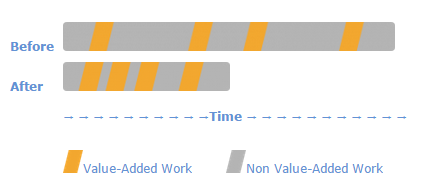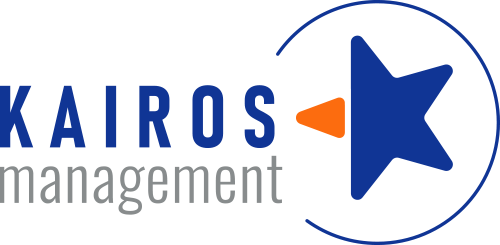Lean
Lean has its origins in the Toyota’s Production System. Its goal is making processes ‘leaner’ – more efficient, flexible and responsive to the customer needs. It does it by continuously looking for and eliminating waste (muda), and by creating flow.


Lean defines 5 key principles:
- Define value – any activity the customer is willing to pay for. Anything else is waste. Always defined from the customer perspective.
- Identify the value stream – the sequence of actions necessary to add value to a product or service, from suppliers to customer.
- Create flow – materials, services, information, transactions must flow through the value stream with minimal interruptions.
- Create pull – no process upstream should produce anything until the customer downstream demands it. The value stream is thus linked to the customer and it operates at the ‘beat’ set by the market.
- Attain perfection – relentlessly apply the previous principles to continuously improve the value stream.
Lean stresses solid operating mechanisms to drive efficient operations and continuous improvement: standardisation, visual management, operator empowerment, quick problem resolution,…

Kaizen
Seek the wisdom of 10 people rather than the knowledge of one.
Kaizen comes from the Japanese terms Kai (change) and Zen (good or perfection) – it thus means ‘change for the better’ or ‘continuous improvement’. Kaizen is stands at the center of Lean as an iterative improvement philosophy and approach: improvements everywhere, everyday, with everybody’s contribution, from small incremental changes to large strategic ones. Some guiding principles:
- Discard conventional fixed ideas. Start questioning current practices.
- Think of how to do it, not why it cannot be done.
- Do not seek perfection. Do it right away even if you’ll only achieve half the target.
- Do not spend money for kaizen. Use wisdom and imagination.
- Keep always a customer perspective.
- Ask why 5 times and seek root causes.
- Engage everyone – seek the wisdom of ten people rather than the knowledge of one.
‘Kaizen events’ are concentrated workshops where the process stakeholders come together, analyse the current situation, set improvement objectives, and implement improvements. Kaizen events help instigate a Lean culture in the organisation: the direct stakeholder involvement and rapid implementation makes them an effective workplace transformation tool.

Six Sigma
Six Sigma focuses in improving quality by reducing process variability, identifying and removing the causes of defects and properly controlling key factors that impact the output of a process.
Six Sigma was developed by Motorola and is based on traditional quality improvement methodologies such as Total Quality Management and Statistical Process control, and the work of quality gurus such as Shewhart, Deming, Taguchi and others.
Six Sigma makes extensive use of statistical tools to measure, analyse and improve business processes. Improvement projects follow the DMAIC structure:
- Define… customer needs, projects scope and improvement objectives.
- Measure… process performance and behaviour.
- Analyse… process to understand the key factors that contribute to the process output.
- Improve… the process: identify, validate and implement improvements.
- Control… the process to ensure improvements are sustainable.
Design for Lean Six Sigma
DFLSS focuses on designing new products, services and processes that are Lean and with built-in 6 sigma performance levels. It uses quantitative tools to establish, quantify and manage customer requirements. It brings creativity techniques to come up with innovative solutions. It challenges everything that does not add value to the customer. And it applies statistical methods to develop, test, validate and optimise design alternatives. It moves from a reactive, build and test mode, to a predictive and optimised model.
DFLSS does not replace established ‘innovation’ processes in the business: new product introduction, IT project management, product engineering, etc. It rather complements them, bringing a customer focussed perspective and tools to help along the ‘innovation’ process.

Change Management
“Better suffer a known evil than change for an uncertain good.” (Spanish Proverb)
Change is disruption; is pushing people out of their comfort zone. It generates feelings of fear, loss of control, confusion. There is a natural tendency to resist it. Successful workplace transformation initiatives must understand the human aspect of change and turn the negative feelings into positive ones: sense of opportunity, sense of focus, confidence, learning opportunity.
We follow change management methodologies and tools inspired in the work done by organisational change pioneers such as Beckhard and Kotter, and widely used by leading companies such as GE. For people to change their dissatisfaction with the status quo coupled with an exciting vision must be greater than the resistance. This leads to a change roadmap:
- Build a burning need.
- Communicate a clear vision.
- Effectively engage stakeholders.
- Lead the change effort.
- Ensure changes stick.
- Align operating systems.



